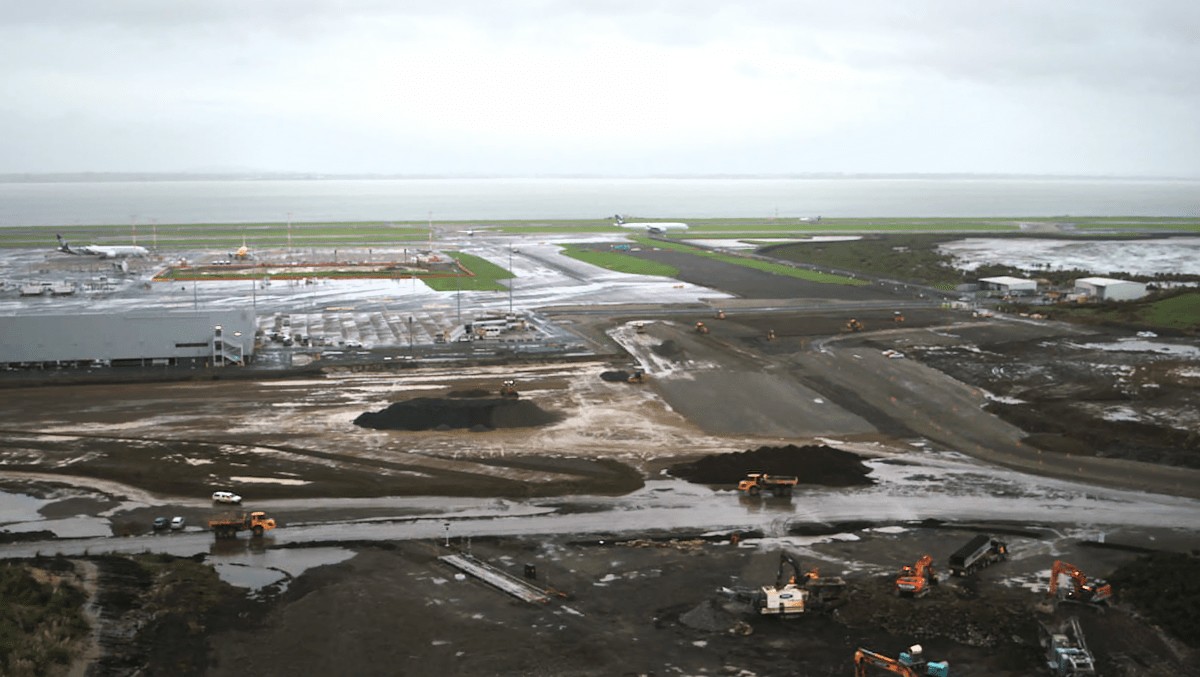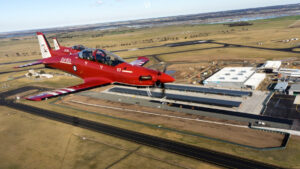
Auckland Airport is recycling old concrete from its runway for a major airfield expansion as part of its $3.9 billion upgrade program.
108,000 tonnes of concrete, previously part of runway touchdown zones, is being crushed and repurposed as backfill for 250,000m2 of new airfield to the west of the international terminal rather than being sent away as waste. Auckland Airport is aiming to divert at least 70% of its construction waste away from landfill or disposal.
“We’ve been underway with pavement renewals across our runway and taxiways for several years now. It’s a necessary and important part of maintaining Auckland Airport’s most important asset. Over the past few years, we’ve replaced hundreds of concrete slabs, which are 36 square metres each,” said André Lovatt, Chief Infrastructure Officer at Auckland Airport.
“Rather than disposing of this old pavement offsite, we’ve been setting it aside, creating a huge mound of 45,000 cubic metres of concrete to the south of the airfield. The old pavement is now being trucked to crushing machines on site for use in the airfield expansion, to be completed between now and mid-2025.”
The expanded airfield will include new taxiways and remote stands for aircraft on layover, with plans to eventually connect a new cargo precinct and a second runway.
“The project was underway prior to the pandemic but was paused in March 2020. We’re thrilled to get going again, particularly given it’s key to constructing our new terminal and will help to minimise disruption to busy airline operations,” said Lovatt.
“The airfield expansion requires a base of approximately 1.5 metres deep, capable of taking the weight of A380s, which are around 280 tonnes. Re-purposing materials allows us to be efficient in how we work and responsible with our construction waste.
PROMOTED CONTENT
“There are new ‘green concrete’ technologies coming into play, which will help reduce construction industry emissions, but one action we can take today is to be really mindful about the materials that have already been created and make sure they continue to be used beyond that original purpose.”
Slated to open in 2028-29, the upgrade project will see New Zealand’s largest airport fully integrate a new domestic terminal into its international terminal, as the existing 57-year-old domestic terminal is almost at capacity and no longer fit for purpose.
The existing international terminal will have new floor space added across two levels via an expansion at the eastern end of the building, with key upgrades also being carried out on the airfield infrastructure including pavement and utilities. Smaller regional flights using turboprop aircraft will continue to operate from the old domestic terminal until a better solution is found.
- SEO Powered Content & PR Distribution. Get Amplified Today.
- EVM Finance. Unified Interface for Decentralized Finance. Access Here.
- Quantum Media Group. IR/PR Amplified. Access Here.
- PlatoAiStream. Web3 Data Intelligence. Knowledge Amplified. Access Here.
- Source: https://australianaviation.com.au/2023/06/auckland-recycles-old-runway-concrete-into-new-airfield/
- :is
- $3
- 000
- 1
- 2020
- 250
- 9
- 91
- a
- About
- across
- Action
- added
- again
- Aiming
- aircraft
- airline
- airport
- allows
- already
- also
- an
- and
- approximately
- ARE
- around
- AS
- asset
- At
- away
- base
- BE
- been
- being
- Better
- between
- Beyond
- Billion
- Building
- busy
- but
- CAN
- capable
- Capacity
- Cargo
- carried
- chief
- COM
- coming
- Completed
- Connect
- constructing
- construction
- continue
- created
- Creating
- deep
- Disruption
- Domestic
- each
- eastern
- efficient
- Emissions
- end
- eventually
- existing
- expanded
- expansion
- few
- fit
- Flights
- Floor
- For
- found
- from
- fully
- get
- given
- going
- Have
- help
- How
- How We Work
- HTTPS
- huge
- Hundreds
- important
- in
- include
- Including
- industry
- Infrastructure
- integrate
- International
- into
- IT
- ITS
- Key
- largest
- least
- levels
- longer
- Machines
- maintaining
- major
- make
- March
- march 2020
- materials
- minimise
- most
- necessary
- New
- no
- now
- of
- Officer
- Old
- on
- ONE
- open
- operate
- Operations
- or
- original
- original purpose
- our
- out
- over
- pandemic
- part
- particularly
- past
- plans
- plato
- Plato Data Intelligence
- PlatoData
- Play
- previously
- Prior
- Program
- project
- purpose
- rather
- really
- recycling
- reduce
- regional
- remote
- Renewals
- replaced
- requires
- responsible
- runway
- Said
- Second
- see
- sent
- setting
- several
- site
- smaller
- solution
- South
- Space
- square
- stands
- Take
- Technologies
- Terminal
- than
- that
- The
- The West
- they
- this
- thrilled
- to
- two
- Underway
- until
- upgrade
- upgrades
- us
- use
- used
- using
- utilities
- via
- was
- Waste
- we
- weight
- West
- which
- will
- with
- Work
- years
- zephyrnet
- zones










